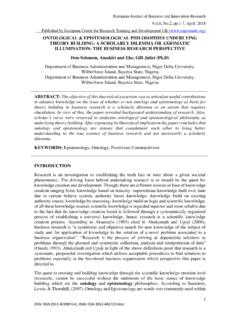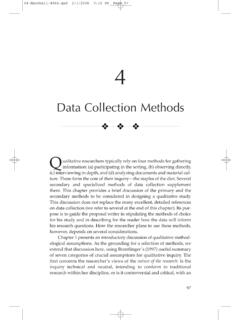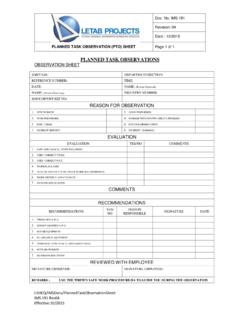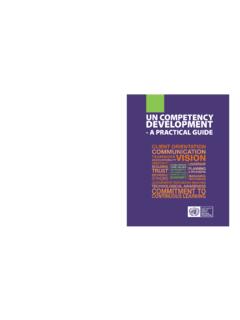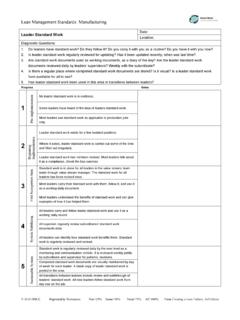Transcription of Auditing and Feedback of PPE Use - Centers for Disease ...
1 1 Auditing and Feedback of PPE UsePresenterLinda R. Greene, RN, MPS, CIC, FAPIC University of Rochester Medical CenterHighland HospitalContributions byKaren Jones, RN, MPH, CICI nfection PreventionistSt. John Hospital and Medical CenterLona Mody, MD, MScUniversity of MichiganAnn Arbor VA Health System2 Learning Objectives Summarize why Auditing and providing Feedback are essential to ensuring personal protective equipment (PPE) adherenceIdentify ways in which to audit PPE useDescribe strategies to use audit and Feedback to improve staff PPE performance3 Why audit PPE use? In order to improve practice it is important that the correct use of PPE be rigorously and consistently appliedA recent study demonstrated that only half of healthcare personnel removed PPE correctly under normal conditionsAudits can provide immediate Feedback and identify gaps in practice4(ZellmerC et al.)
2 , AJIC, 2015)Who Should Be Audited? Anyone who has to use PPE in the course of their job duties. This includes: All licensed health care personnel All unlicensed health care personnel Physicians Volunteers Trainees5 What does the audit process involve?Starts with competency based trainingDemonstration of selection of appropriate PPEA bility to locate PPED emonstration of correct donning and doffingTrainee demonstration of correct donning and doffingRegular audits for adherence6 Frequency of Audit and Re-EducationAudit should take place at regular intervals as defined by the organizationIt is also important to re-educate and audit whenever there is a change in equipment or supplies and if rates of HAIs are high or increasing. 7 planned vs. Random ObservationsPLANNED OBSERVATIONSPROSCONSCan be scheduled to ensure that all individuals demonstrate regular competencyUnable to determine behavior during the routine course of dutiesScenarios can provide Feedback on individual s ability to choose PPE appropriate for the situation8 RANDOM OBSERVATIONSPROS CONSA bility to assess adherence during normal workRequires large number of observations on all shifts Direct observation Checklist9 Family MembersThere are no standards for Auditing family membersOrganizations should develop policies to address specific PPE that family members are required to wear10(Image from AHRQ Module)What about Feedback ?
3 Feedback should be: Specific When a break in protocol is identified, it should be specific Timely immediate Feedback is the most effective Non-threatening the Feedback should be given in a manner that is non-threatening11 SpecificTimelyManner(Image from AHRQ, TeamSTEPPS, Module 3. Communication)Types of Feedback 12 Type of FeedbackHow it WorksBenefitsImmediate FeedbackFeedback given at the time of the occurrence Can be given by anyone; including observers, managers,supervisors or peersPlanned FeedbackFeedbackgiven at pre-determined intervals through a type of measurement systemUsually the responsibility of a designated department or assigned roleCulture of Safety A "culture of safety" encompasses the following: Acknowledgment of the high-risk nature of an organization's activities and the determination to achieve consistently safe operations A blame-free environment where individuals are able to report errors or near misses without fear of reprimand or punishment 13 Encouragement of collaboration across ranks and disciplines to identify unsafe practices and seek solutions to patient safety problems How do we use audit data?
4 Data on adherence should provide valuable information to drive information can identify gaps in practices which helps the organization set priorities and develop improvement plans14 PPE Auditing Data15 Initial gaps observed: Glove and gown donning and doffing Failure to wear gown if indicated Touching face when removing face maskAggregate Audit Data 16 What s the Bottom Line ? Regular audits to monitor adherence to PPE should include: Appropriate selection Donning Doffing Hand hygiene Environmental contamination Evaluation of appropriate supplies and equipment Proximity of supplies to point of useAggregate data can be provided to identify opportunities for FarinA. Compliance with routine use of gowns by healthcare workers (HCWs) and non-HCW visitors on entry into the rooms of patients under contact precautions. ; 28(3): 337-40. KilincB. Isolation gowns in health care settings: Laboratory studies, regulations and standards, and potential barriers of gown selection and use.
5 AJIC. 2016; 44;1: use in Healthcare Settings. Centers for Disease Control and Prevention. for Donning and Removing Personal Protective Equipment. Centers for Disease Control and Prevention. NotesSpeaker Notes: Slide 1 Hello, and welcome to this module titled Auditing and Feedback of PPE Use. This is the fourth module of the Personal Protective Equipment, or PPE, course. We will review the critical role of Auditing for effective PPE use and key strategies for providing Feedback to prevent healthcare-associated infection. 20 Speaker Notes: Slide 2 This module was developed by nation infection prevention experts devoted to improving patient safety and infection prevention efforts. 21 Speaker Notes: Slide 3 There are three objectives for this module. The first is to be able to summarize why Auditing and providing Feedback are essential to ensuring personal protective equipment or PPE adherence.
6 The second is to identify ways in which to audit PPE use; and the third is to describe strategies to use audit and Feedback to improve staff PPE performance. Understanding these three core objectives will set the groundwork to improve the culture of safety related to infection prevention in your health care organization. 22 Speaker Notes: Slide 4 The Ebola crisis highlighted the need for meticulous attention to donning and doffing PPE. Though PPE is essential, it does have limitations that not only stem from being employed correctly, but also from being removed safely. A recent publication highlighted a systematic evaluation of health care worker removal of PPE for Contact Isolation . This publication demonstrated that only about half of health care personnel remove PPE correctly. What can we do about this? One important action is to conduct audits. Audits can provide immediate Feedback to staff using PPE incorrectly and can also help identify gaps in practice and Notes: Slide 5So who should be audited?
7 Anyone who has to use PPE in the course of their duties. This includes all licensed health care personnel, all unlicensed health care personnel, physicians, volunteers and Notes: Slide 6 The first two modules on Standard Precautions and Transmission-Based Precautions provide basic education on PPE. However, it is extremely important to audit and provide Feedback to health care personnel on PPE use. 25 Speaker Notes: Slide 6 ContinuedAudit and Feedback are important foundational elements to ensure that health care personnel are competent to perform their duties. Competency-based training means that staff not only receive education, but can demonstrate adequate performance of their job duties. This training involves education regarding the selection and use of appropriate PPE followed by a step by step return demonstration of how to properly use it. It is also important that the step-by-step training mirror the organizational policy or procedure.
8 In addition, there should be documentation of training and written confirmation that the person has demonstrated the ability to select, don and doff PPE correctly based on the Notes: Slide 7 The health care organization should define the process and time frame for PPE audits. In order to assess adherence, it s ideal to conduct random audits during actual provision of care. However, it is also possible to obtain important information during an activity and demonstration of selection and use of Notes: Slide 8 There are two different types of Auditing called random and planned observation . The pros and cons of each observation strategy are highlighted on this slide. One method of planned observation is to conduct regularly scheduled assessments of all persons who may use PPE. This method may be supplemented by random observations, which provide valuable information regarding real life practice and the ability to provide Feedback and teaching in the moment.
9 Ideally, an organization should use a combination of both of these Notes: Slide 9 This slide shows a planned observation checklist which can be used to audit adherence of PPE. This form is adapted from similar tools developed by the CDC. Tools and checklists are very helpful during audits. You may wish to consider using and adapting a similar checklist to match your hospitals policies and procedures. 29 Speaker Notes: Slide 10 When family members are required to use PPE, health care personnel should provide education and training on hand hygiene and appropriate donning and doffing. Auditing and Feedback for this group should be immediate and non-threatening. For example you may say something like: Mrs. Smith, let me stop and show you how to apply that face mask , let me see you apply it like I demonstrated. We just want to make sure we keep you and Mr. Smith safe.
10 30 Speaker Notes: Slide 11 Let s now move on to talk about strategies for providing effective Feedback , if you notice errors in PPE use or your Auditing reveals user gaps. This slide identifies the three essential components of Feedback : it must be specific, it must be timely and it must be given in a non-threatening manner. Health care personnel should be given Feedback as soon as possible and the specific issue should be addressed. For example, you might say something like, Hi Sally, when you removed your face mask, you accidently touched your face and contaminated yourself. I just want to make sure we keep you safe. Feedback should also be given in a manner that will help improve performance. And often, this provides a coaching Notes: Slide 12 Let s now talk about some of the different types of Feedback . First type, is immediate Feedback . Information is identified and shared as soon as it s directly noticed during a patient care activity.












